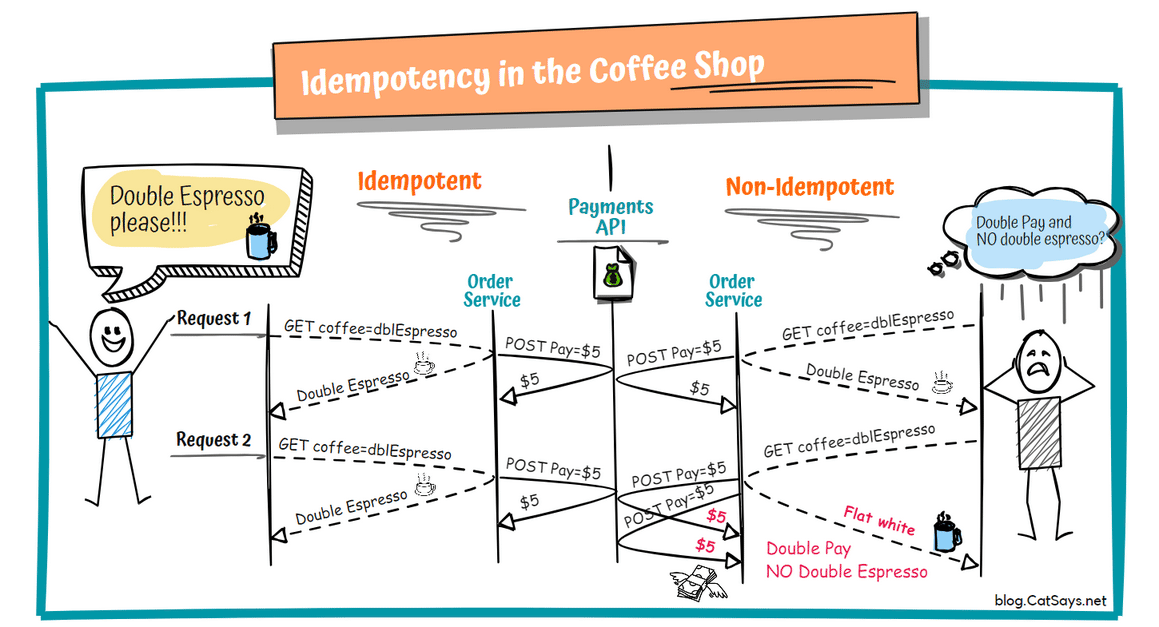Brewing the Idempotency Interview Question
Decoding Consistency and Reliability: The Idempotency Principle in Software Engineering

One question I often ask in interviews and mentoring sessions, which rarely gets an answer, is subtly revealed in the story that follows. Immerse yourself in this narrative to discover the answer.
Join me on a journey inside the warm, inviting atmosphere of a coffee shop, where the concept of idempotency unfolds through a tale of consistency and unexpected outcomes.
The Idempotent Order in the Coffee Shop
Imagine a charming coffee shop in the city's heart, a sanctuary for those addicted to caffeine and passionate about coding. We meet Alex, a developer who, between sips of espresso and crafting code, discovers the essence of idempotency.
One crisp Monday morning, Alex orders their usual double espresso. The barista, skilled in the art of coffee and consistency, prepares the drink, exactly as requested. The next day, craving the familiar kick of caffeine, Alex orders the same double espresso. The result? Identical to the day before - same taste, temperature, and energising effect.
This routine of ordering the same coffee and receiving the exact same result every time reflects the principle of idempotency in software development. Just like Alex's double espresso, an idempotent operation ensures that no matter how many times a request is made, the outcome remains unchanged after the initial execution. This principle is crucial for developing resilient, predictable systems where repeated actions have no additional effects.
The Non-Idempotent Twist
Yet, on a particular Wednesday, after placing their usual order, Alex was surprised to receive something quite different: what seemed more like a caramelised flat white than their expected double espresso. This unexpected variation, despite the same request, highlights the nature of non-idempotent operations. In software terms, it's like when actions, if done over and over, lead to different results or effects, like putting a new item in your shopping cart each time or sending an email.
Disappointed, Alex uses the self-order machine the following day, Thursday, hoping for a seamless experience. Still frustrated from the previous day's surprise, Alex accidentally double-clicks the "Pay" button on the payment screen. Astonishingly, Alex is charged twice for a single coffee. This other instance of non-idempotent behaviour, where the operation behaves unexpectedly, highlights the vital need for a proper understanding and implementation of idempotency.

Unravelling Idempotency: The Key to Reliable Software and Microservices
The interview question, which puzzles many developers, is indeed: "What is idempotent in software development?"
The term "idempotent" comes from mathematics, specifically from algebra, where it describes an element that, when multiplied by itself, yields itself.
Idempotency is a fundamental concept in computer science and software engineering, especially relevant in distributed systems and API design. It means that no matter how many times an operation is performed, it produces the same result as doing it just once, without any additional side effects.
Designing idempotent APIs and web services is crucial to ensure that clients can retry requests after encountering errors or network issues, without risking unintended system changes. For example, if a service responsible for processing payments adheres to idempotent design, accidentally sending the same payment request multiple times will not result in a user being charged more than once.
In the world of microservices, where communication is often asynchronous, idempotency is essential. It ensures that even if the same event message is received multiple times by a service - perhaps due to message bus retries or network issues - the operation will only be executed once, preventing duplicate actions.
This characteristic is a critical safeguard in environments where services communicate without waiting for immediate responses, ensuring consistent and reliable outcomes.
Alex's experiences in the coffee shop offer a practical view of idempotency (and its absence) in technology. From API development, where idempotent methods like GET, PUT, and DELETE offer safety and reliability, to the unpredictable nature of non-idempotent POST requests, idempotency affects various software development aspects.
Reflecting on Our Coffee Shop Story
Alex's journey captures idempotency's essence in a relatable way. It reminds us that in technology, as in life, understanding the nature of our requests and their consequences is key for creating experiences that are both satisfying and consistent.
Mastering idempotency demonstrates a developer's ability to protect and improve systems with best practices, emphasising creating solutions that serve and benefit end-users.
This often misunderstood yet crucial principle is the foundation of building resilient and reliable systems. Let it guide our digital creations and coffee orders towards consistency and reliability.

